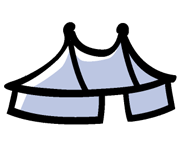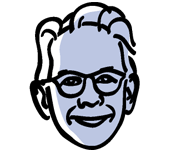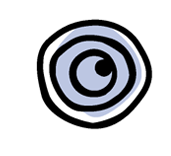TouteLaCulture.com27 September 2018
“La dernière saison” by Cirque Plume: a visual poem visuel in the guise of a farewell

★★★★
Cirque Plume has laid down its suitcases at La Villette for one last time, from September 26 to December 30. The show, aptly titled La Dernière saison (“The Last Season”) is a testimony to the ground broken by the artistic team over the past 30 years. Plume has made its mark across the four corners of France: its mix of circus, clowning, visual theatre and live music make for an impressionistic work developed through small touches. A must see!
A show in the form of a poetic proposal
A show by Cirque Plume always surges towards poetry: an atmosphere translated through gestures and sounds, a story that is more than narration — one that attempts to transpire through every possible pathway, making way for the magic of the show.
In this case, La Dernière saison is a journey in time, not in a linear time in which endings come as shocks that open to nothingness, but in a circular time, the time of the world and of seasons, where everything dies to give place to new births: a great movement that at once embraces what it projects forward.
The place chosen to represent these cycles is the forest, symbolized on stage by two majestic tree branches suspended from the stage’s grid. This is a pretext to summon the animality of the artists. It’s an opportunity to bring nature into the set. It’s a way to call on the audience to reconnect at a pace that is etched in the species’ legacy.
Cirque Plume has attempted to place these drives into the heart of its creation, for this show will be its last. Acknowledging, with its audience, the end of a cycle, which is only the extension of others, and the beginning of new ones. Celebrating the spectacular and sharing the dream, not looking back with nostalgia, but all the while not refusing to bear the trace of the past. A show of wisdom and maturity, in short.
A proven formula
In this way, the scenic proposal consists of primarily the same formula that has marked Plume’s success since its beginnings. It’s not so much a pure circus show as it is an augmented circus show. Augmented with everything that gives it life, joy, communion: around and beyond circus numbers, music is omnipresent, clowning is generously summoned, scenes are constructed with a careful search for a strong visual aesthetic. No fan of Cirque Plume’s work will be out of place.
The grace of physical performance
Looking on the circus side of things, we have a lot of acrobatics and aerial apparatuses. Down from the Cyr wheel, rising onto the tightwire, Chinese pole, aerial hoop. Only contortion remains at the ground level of the stage. Distilled in a balanced way throughout the show - which lasts 1 hour 50 minutes - the numbers are all mastered with great technical precision. When there are mistakes, they are assumed with grace. Analia Serenelli’s passage on the aerial hoop, which almost opens the show, is a gem of hypnotic grace, but her circus companions are not left behind in their disciplines - it’s a safe bet that many spectators will have been impressed by the contortion of Anaëlle Molinario.
On the physical level, dance is also very present. Analia Serenelli also stands out in her flexibility, her precision, her fluidity of execution. The "pure" dancers are not left behind, and form some very nice moments of suspended time, performing in imaginary lakes and dancing around snowflakes.
In an equally physical way, certain artists play somewhere between clowning and performance, exploring an animality, which, removed, from all the artifices of modern life, remains nevertheless infinitely troubling because it is inevitably linked to our deep nature as human beings. Cyril Casmèze brilliantly enters this troubled space where bipeds can still yield to the drive to bend back to the ground: he is very funny while at the same time succeeding in engaging in something primal and wholly convincing.
The omnipresence of humor and music
We find the presence of humor and of a certain lightness throughout the show. Some of the artists are on stage only to perform comic roles - purely visual or clowning parts, such as when Santa Claus and Père Fouettard quarrel in the middle of the stands - while others share a musical or circus “function” along with a clownish character. Natalie Good, who distinguishes herself on the tightwire, also plays an extremely expansive character the whole time. For the audience, this is one of one of the points of attachment which helps tie together the entire show. It should be noted in passing that all the characters highlighted here, especially those of the four female circus artists, are very individualized and, therefore, absolutely not interchangeable. This effort of writing colorful and distinct characters into the show, with female characters who are not very caricatural, must be applauded.
And, of course, since this is a Cirque Plume show, the music is a backbone of the ensemble. Although it is sometimes played almost independently of the action, like a concert, most of the time it is deeply married to the actions of the other artists on stage. This is obvious for dancers. But it’s just as true throughout the rest of the show, from the circus acts, which burst through the musical atmosphere that carries them, to the comic numbers, where percussion can for example become an integral part of the proposal.
The composition work of Benoit Schick deserves to be deeply applauded: at times a sharp melody that would make Jeunet proud, at times a wrenching blues evocative of Tom Waits. The musical landscapes are varied and colorful. The different performers enjoy themselves on stage, and their pleasure is communicative.
A beautifully mastered visual world
Another characteristic of Cirque Plume shows is the overall beauty of the scenography. As usual, special attention has been paid to the visual aspect, so that the constantly changing scenes are balanced, delicate but strong. All the acrobatic and aerial passages were particularly carefully crafted. The final scene, with its umbrellas, even if it relies on well-known images, is in itself worth the trip. The materialization of the moon by the play of light is an idea full of poetry.
The staging, as usual here, playfully exploits the black box and the stage setting to the maximum. The possibility of creating different depths and shadows through the use of veils and curtains is exploited throughout the show, sometimes distilling a mysterious atmosphere that befits the vaguely disturbing place that a forest can be. The performers’ entrances and exits are well developed. The play on light, which cuts across emerging shadows, also develops a feeling of strangeness.
An ensemble lacking fluidity
And yet, in spite of the marriage of all these elements, which, individually, push to deliver only praise, one remains a little less charmed, a little less transported than usual. After watching Tempus Fugit?, the previous opus in the long and prolific history of Cirque Plume, one left feeling suspended, in a state of grace. La Dernière saison, despite its undeniable qualities, lacks a little something from this point of view.
Perhaps we must look at the exhaustion of ideas and formulas. La Dernière saison is very typically a Cirque Plume show, with all that characterizes it. Nothing in the show is new or surprising, if everything is mastered and cleverly arranged. No image, no movement, no trick comes to surprise anyone accustomed to these kind of shows. It might be possible to mention the presence of the double wire, but the inventions stop there.
That would probably not be enough, on its own, to explain why one does not let oneself be entirely won over by the proposition ... Perhaps, despite the strength of some of the scenes, the show lacks fluidity as a whole. One often has the feeling that the scenes are brutally cut off from one another, that one switches from one world to another without continuity or blending. As if, plunged into a dream, one is suddenly summoned to wake up, and to immediately adhere to another. These shocks, often repeated, slightly break the state of benevolent connivance that must be felt in the audience in order to achieve total immersion.
This is perhaps also the sign of a show that must find its bearings in a new space with new acoustics. There is no doubt that the run under the canvas tent of La Villette will allow it to acquire greater harmony between scenes.
The fact remains that this show, poetic from start to finish, is admirably mastered, from both a technical and an emotional point of view. It is the opportunity to salute one last time the admirable work of a troupe that has contributed, through its demanding performances, to the renewal of what circus can so beautifully offer its audiences. Just for that, the trip is worth making.
Cirque Plume is at La Villette until December 30, and will then continue to tour La Dernière saison until 2020 — stay informed!
Mathieu Dochtermann








